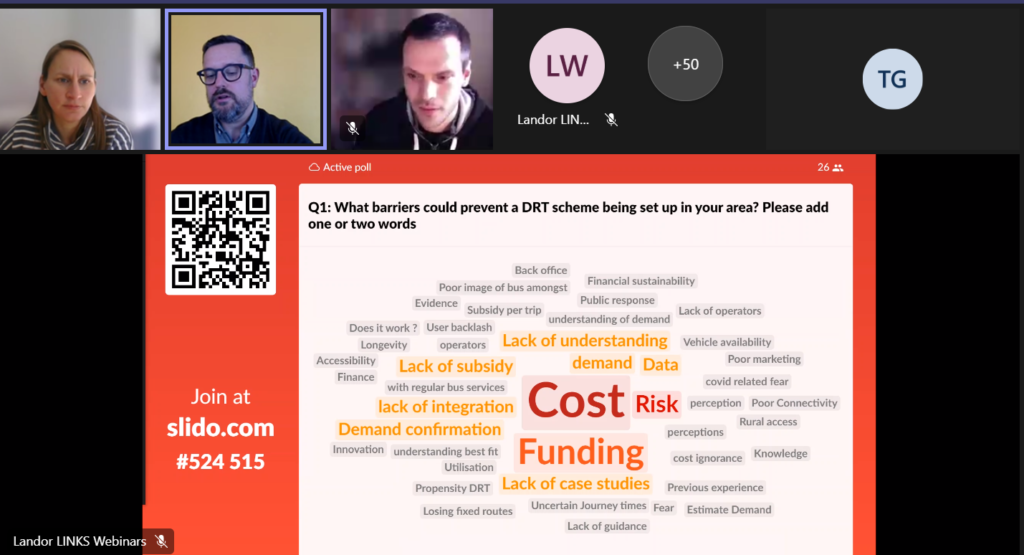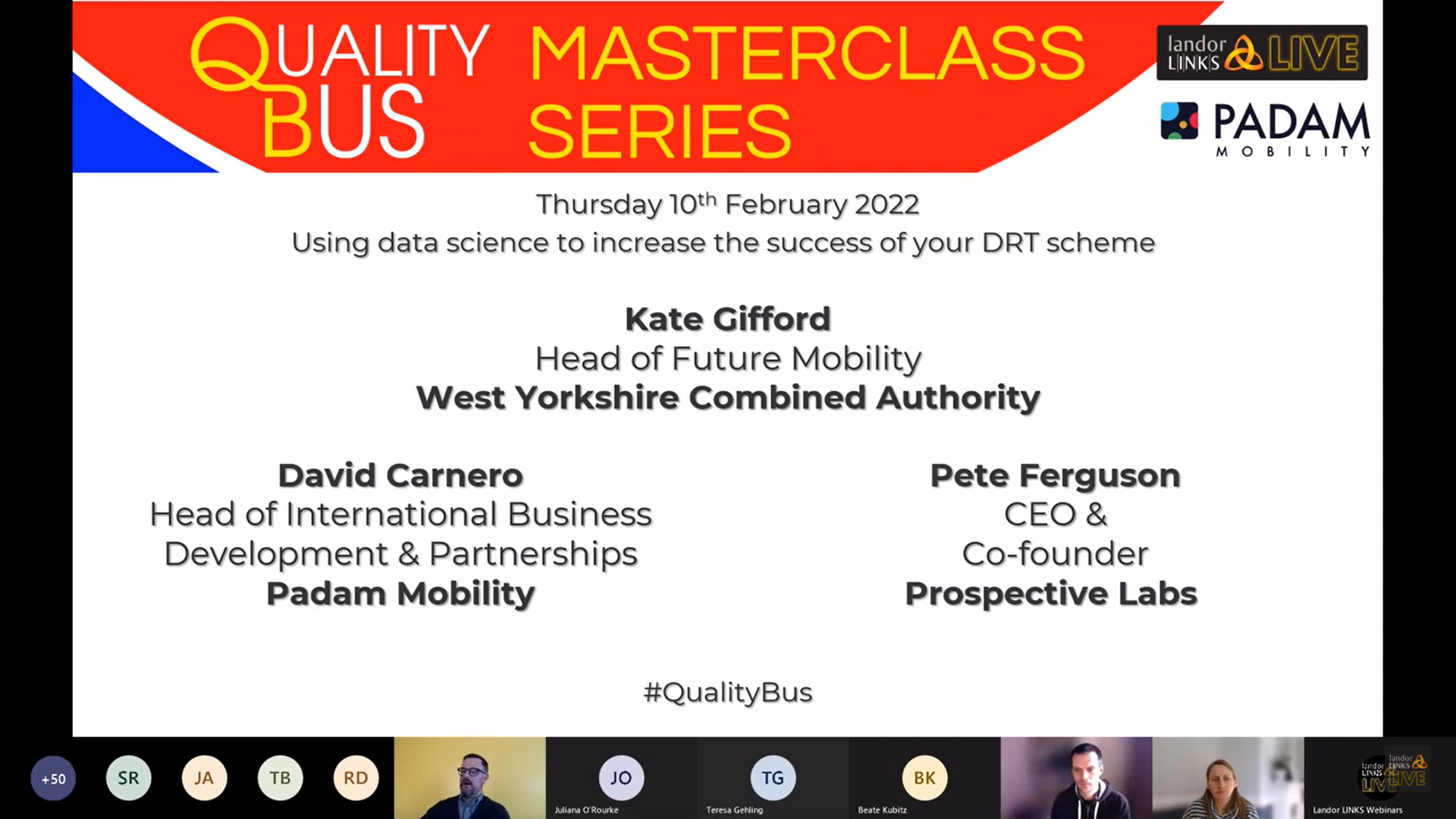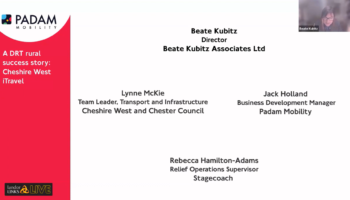Padam Mobility and Prospective Labs, in collaboration with Landor Links, present the second edition of the Quality Bus Masterclass Series.
Kate Gifford, Head of Future Mobility at West Yorkshire Combined Authority, led the hour-long discussion of Demand Responsive Transport (DRT) and Data which featured Pete Ferguson, CEO and Co-Founder of Prospective Labs, and David Carnero, Head of International Business Development and Partnerships at Padam Mobility.
The webinar took questions from participants and discussed the role of data in setting up and shaping DRT services.
What data sets will I need for a feasibility study (and if this involves bus data,
how do I reassure the operator that supplying the data won’t have an adverse impact
on their existing business)?”
The Prospective Labs approach to data is about understanding the potential role of DRT within the transport network – and where it might have real competitive advantages over the private vehicle.
Pete Ferguson:
We utilise a lot of the ticketing and timetabling data from the core public transport network and we combine that with essentially the core transport modelling activity that you may be aware of within your own local authorities that is looking at the propensity to travel under different conditions. How sensitive are local populations to changes in travel time, changes in costs and what will their behaviour be when you make that change.”
Another important source of data from which Prospective Labs draws information is the National Travel Survey, which provides about 100,000 responses annually, relating to different preferences depending on the mode of transport or reason for travel.
All this data is cross-referenced with the ‘supply side’, i.e. the structural, multi-modal public transport network across the UK.
There’s a core of national data sets that then can be combined with a rich representation of the actual underlying supply network”
This broad pool of data allows Prospective Labs to understand what would happen if any changes were made to public transport services in a particular region.
Because DRT can be configured in different ways, the impacts of different configurations can be checked. In some areas, it may make sense to maintain a fixed route structure that is then served ‘on-demand’, in other regions it may be more effective to operate in a free-floating model, and still others may benefit from the DRT service simply acting as a feeder or drop-off for central transport hubs.
David Carnero:
[It is about] understanding where the structural network is, what frequency it is running, what is the network coverage, etc. [From our side] we can implement the DRT in a way that it doesn’t compete with the structural transport network. […] We have a not-compete functionality in our platform, […] and so if somebody asks for a journey between point a and point b and that journey can be done by a fixed line bus then we will not accept the DRT journey and actually refer them to the specific timetable, to that bus line for example.”
A good study will be able to reassure the existing operators that the DRT services will enhance the network rather than detract from it.
“Data collection can be expensive and DRT schemes present financial challenges. How can the additional spend on data collection be justified?”
Collecting and evaluating relevant data, especially before an on-demand service is to be put into operation, contributes decisively to the success or failure of the new transport offer.
David Carnero:
The role of data from our perspective is really to de-risk a project, it can contribute to reducing costs, it can allow, for example, the right supply to be put in place at the right time. […] It takes away a lot of the surprises that can happen. […] We look at it as well as the base on which you build your hypothesis at the beginning if there isn’t a previous DRT service and then you have something really concrete that you can measure against.”
Pete Ferguson adds that it’s more about the cost of not collecting and analysing data:
A few weeks of paying for drivers and vehicles for a poorly set up service is ultimately much more costly than upfront planning and data analysis. A possible later readjustment, in the case of a poorly running service, would therefore be more fatal than the investment in a thorough implementation process could possibly be.”
It’s crucial to use data expertise in decision-making, assessing the characteristics of a region and the behaviour of (future) service users and provide advice on the likelihood of success for each potential type of service.
We can look at concepts like the ‘consumer surplus’ which is useful for gauging what additional services or destinations that people can access with this additional connectivity. It’s good for both looking in the increase of the value to passengers, but also can be used to ensure minimal impacts if we’re trying to cut costs. Essentially you consider the least reduction in consumer surplus for each cost-cutting scenario”.
Padam Mobility partners with Prospective Labs because: “We have recognised that the need for data analysis of mobility behaviour in certain regions is very high for public authorities, but for various reasons often cannot be carried out independently”, says David Carnero.
In the event that DRT metrics show a decline in performance, what mechanisms can be used to identify problems early and trigger mitigating action?
Initially, Prospective Labs works to develop reliable scenarios that are very close to real-world scenarios, so that there’s a model to predict how well the DRT will be used which can be validated against the real world. So the first thing is to establish how well this process is working and use the model to predict how adjustments might be implemented.
In addition, long-term analysis of data from the platform is important, explains David Carnero:
We analyse the supply, we analyse how people are searching within our digital products and, for example, if there are lots of searches that aren’t what we call it ‘converted’ we then look to understand what’s happing. Things like where are the origins, where are the destinations? Do we need to extend the zone?”
Using this approach, the service can be adjusted to provide the best and most cost-effective solution for the area, passengers and the operator.
If you’d like to hear more questions about DRT and data answered, the masterclass on DRT and data is available in full length on YouTube.
What hurdles do decision-makers and mobility managers see in the introduction of an on-demand service?

According to the audience, concerns about unmanageable costs or unmanageable risk seem to be particular obstacles to setting up DRT in certain regions. This is a dilemma because if DRT services are rejected outright, best practices cannot be developed, which can slow down the overall evolution of new transport services.
What comes next?
Assuming the planning of a DRT service has been successful and the service has been running for some time, how should data continue to be used to improve the service or even identify and fix problems?
The next Masterclass will be about this very topic: Scaling DRT – Using a flexible demand platform and a flexible vehicle supply model to grow patronage efficiently.
This third and final masterclass by Padam Mobility will explore the levers and measures that are available to efficiently operate on-demand bus schemes.
Dan Mould, Managing Director Of Coachscanner will be outlining his unique supply-side platform (We-DRT) for operating DRT using a mixture of permanent and flexible bus suppliers. This will include learnings from operating TfWM West Midlands On-Demand Service.
Jack Holland, Head of Business Development in the UK for Padam Mobility will be sharing his experience of managing and growing DDRT services over the past 4 years. He will go through how to make full use of DRT software including the levers for marketing and price elasticity.
This next Masterclass will take place on 10 March at 10:30 GMT. You can register for this event by clicking on this link. As usual, you are also welcome to send us your questions!
About the Quality Bus Masterclasses in association with Landor Links
The Masterclass series was created primarily to help decision-makers understand how DRT can be incorporated into an Enhanced Partnership Programme between transport operators and public transport authorities in the most risk-free way possible.
You can also watch the video of our first Masterclass at this link. Here David Carnero together with Matt Smallwood and Antonio Carmona talked about the topic “Integrated Ticketing”.




